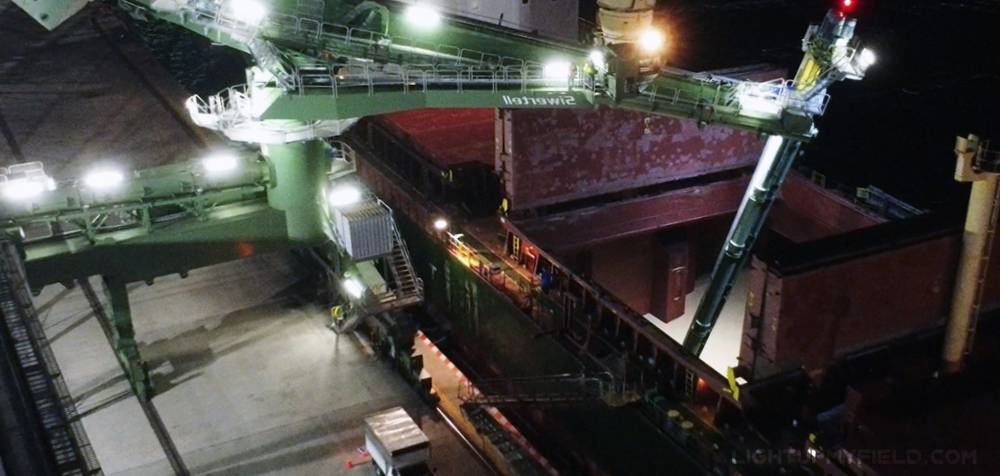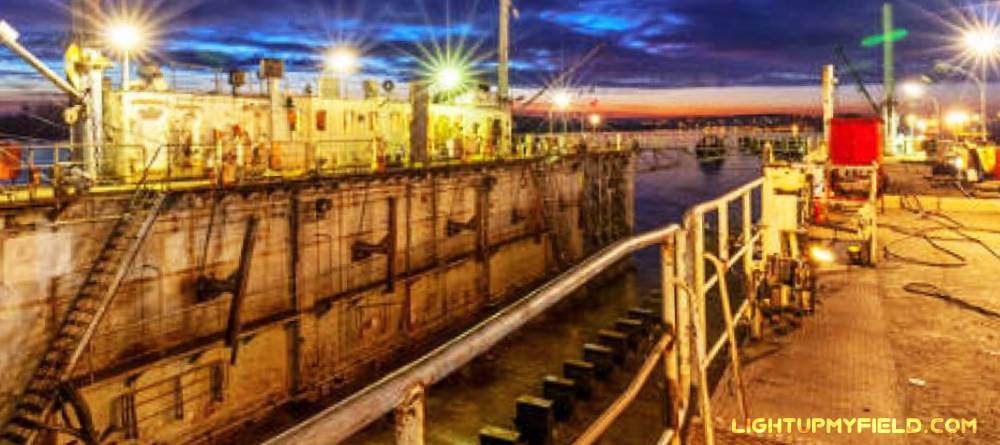The amount of light you have—measured in lumens—makes a big difference in how well workers can see, how safe the area is, and even how energy-efficient the whole setup ends up being. But how many lumens does a dry dock really need? Let’s break it down.
Table of Contents
ToggleWhat Are Lumens and Why Do They Matter in a Dry Dock?
Lumens measure the total amount of visible light a source gives off. It’s basically the brightness you get from a lamp or fixture. So, when someone says, “How many lumens do I need?” they’re asking how much light is actually reaching the surfaces and spaces workers need to see clearly.
You might think wattage tells the whole story, but that’s more about how much power the light uses, not how bright it is. For example, an old 400-watt metal halide lamp might produce 28,000 lumens, but a 150-watt LED could produce the same or more lumens while using less energy.
In a dry dock setting, where precision, safety, and visibility are all at play, understanding lumens helps you get the right brightness level. Too little light can lead to accidents or mistakes, while too much light wastes energy and can cause glare or discomfort.
That’s why measuring and specifying lumens properly is a big deal when planning dry dock lighting.

How Many Lumens Are Needed for Different Areas of a Dry Dock?
Lighting needs can really change depending on what part of the dry dock you’re talking about. Some spots need bright, focused light to get detailed work done, while other areas just need enough glow to keep people safe and comfortable. Let’s break down what kind of lumen levels you might be looking at for various zones.
| Dry Dock Area | Recommended Lumens per m² (Lux) | Typical Area Size (m²) | Total Lumens Needed |
|---|---|---|---|
| General Yard & Storage Areas | 100 – 200 | ~1,000 | 100,000 – 200,000 |
| Heavy Repair & Maintenance Zones | 300 – 500 | ~500 | 150,000 – 250,000 |
| Inspection & Quality Control | 500 – 1,000 | ~100 | 50,000 – 100,000 |
| High Mast & Wide-Area Lighting | Fixtures ~90,000+ lumens each | ~10,000+ | 1,500,000 – 2,000,000+ |
General Yard and Storage Areas: Just Enough Light to Keep Things Safe
In most general parts of a dry dock, like walkways, storage areas, or places where heavy detail work isn’t happening, you don’t want to overdo it with brightness. The goal here is to make sure everyone can move around safely, spot obstacles, and avoid accidents without squinting or dealing with harsh glare.
Usually, something around 100 to 200 lumens per square meter—which is also called lux—is good enough. For a typical dry dock yard that might cover about 1,000 square meters (that’s roughly the size of a small soccer field), you’d be aiming for something like 100,000 to 200,000 lumens total. This level of light keeps things visible and comfortable, without wasting energy on over-bright lighting where it’s not needed.
Because these general areas often have lights on for long hours—sometimes even overnight—keeping the lumen level moderate helps control energy costs without compromising safety.
Heavy Repair and Maintenance Zones: Lighting That Helps Get the Job Done Right
When you move over to areas where heavy repairs or maintenance work happens, the story changes. Here, crews are welding, painting, or handling complex mechanical fixes, which means they need stronger, clearer light to avoid mistakes and keep things safe.
Experts recommend around 300 to 500 lumens per square meter for these zones. To visualize, if your repair bay covers 500 square meters—about half a football field—you’d want between 150,000 and 250,000 lumens focused there. That’s quite a bit more than the general yard because welders need to see sparks clearly, painters need consistent light to check coats, and mechanics want to spot any small issues on parts.
Bright and steady light also helps reduce shadows, which is a big deal when you’re working with moving equipment or dangerous tools. If lighting is too dim, workers might miss a step or overlook a hazard.
Inspection and Quality Control Areas: When Every Detail Counts
The inspection and quality control zones are where lighting has to really step up. These areas are usually indoors or partially sheltered, where workers examine welds, coatings, or mechanical components very closely. The tiniest flaw could be a big problem, so lighting needs to be bright and consistent.
Typical lighting levels here range from 500 to 1,000 lumens per square meter. Let’s say your inspection zone is about 100 square meters—roughly the size of a large conference room. You’d want a lighting setup that provides between 50,000 and 100,000 lumens, concentrated exactly where the inspections happen.
One bonus here is that modern LED fixtures can offer cleaner, whiter light, which helps workers see true colors and small defects better than older yellowish or dimmer bulbs. That can make a real difference when you’re looking for cracks in welds or subtle paint imperfections.
High Mast and Wide-Area Lighting: Bright Beacons From Way Up High
Now, for the big open dry dock spaces where lighting is mounted high up—usually on poles between 20 to 30 meters tall—the approach changes again. Because the light has to travel a long distance down and cover a wide area evenly, you need fixtures that crank out serious lumens.
It’s not unusual for a single high mast light fixture to produce 90,000 lumens or more. Imagine having 10 or more of those spread around a large dry dock covering several thousand square meters. Your total light output can easily hit the millions of lumens range.
For example, a dry dock stretching over 10,000 square meters might have a dozen high mast poles with multiple fixtures on each, pumping out a combined 1.5 million to 2 million lumens or even more. This kind of lighting ensures that every corner of the yard is visible, even on the darkest nights or during bad weather.
Having that much light helps crews work safely around massive ships and heavy equipment, and it also improves security by cutting down on shadows where trouble might hide.

What Happens If You Have Too Many or Too Few Lumens?
Getting your dry dock lighting just right isn’t only about saving on electricity—it also plays a big role in how comfortable and safe the workspace feels, as well as how well the work gets done.
What If There Aren’t Enough Lumens?
When lighting is too dim, parts of the dry dock can turn into shadowy zones where it’s tough to see what’s going on. That’s a recipe for mistakes and accidents. For example, if welders don’t have enough light, they might miss cracks or weak spots in the metal. Inspectors could overlook tiny defects in coatings or welds because the light just isn’t strong enough. Even more basic, workers could trip over tools or debris that aren’t clearly visible, leading to injuries.
On a bigger scale, low light slows down work. When crews have to squint or double-check everything, tasks take longer, which can push up labor costs and delay project deadlines. In some cases, companies might need to schedule extra lighting or bring in portable lamps, which adds hassle and expense.
Some studies show that poor lighting conditions can reduce worker productivity by up to 20%. So skimping on lumens might save a bit upfront, but it often costs more in the long run.
What If There Are Too Many Lumens?
It might seem like more light equals better visibility, but overdoing it has its own downsides. Blasting too many lumens can cause harsh glare, which is super uncomfortable and can even be dangerous. Imagine a crane operator trying to focus on a load while bright lights bounce off metal surfaces, temporarily blinding them or making it tough to see controls clearly.
Bright, uneven lighting can also create deep shadows that hide hazards instead of revealing them. This can happen when fixtures aren’t placed or aimed properly, leading to confusing contrasts that tire the eyes quickly. Over time, workers can experience eye strain, headaches, and fatigue, especially during long shifts under intense light.
From a cost perspective, cranking up the brightness beyond what’s needed means higher electricity bills. For example, if you overshoot your lumen requirements by 30%, your energy costs can rise by the same margin, which adds up fast in a large dock running 12+ hours a day. Plus, running fixtures at maximum output all the time can shorten their lifespan, leading to earlier replacements and more maintenance.
Finding the Sweet Spot
The goal is to hit a comfortable middle ground—enough light to keep everyone safe and efficient without wasting power or causing discomfort. Getting your lumen levels right for each specific area of the dry dock helps make sure work moves smoothly, eyes stay fresh, and your utility bills don’t spiral out of control.
In the end, smart lighting design isn’t just about brightness; it’s about quality and balance. The right lumens, combined with good fixture placement and proper shielding, keep the dock well-lit without blinding or draining resources.

